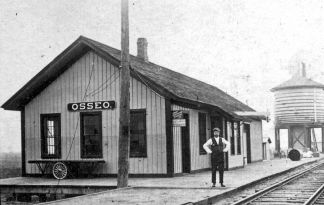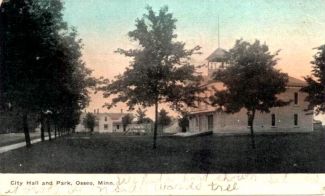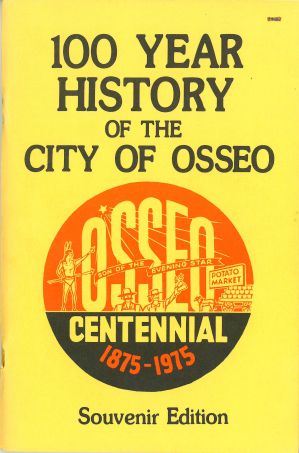History


The City of Osseo is located in the northeastern part of Hennepin County, Minnesota. Originally Osseo was under the government of townships of Brooklyn Park and Maple Grove. In the Spring of 1875, by an act of the state legislature, Osseo was incorporated with a president, three councilmen, a recorder, and a treasurer constituting its officers.
"This is Paradise," Pierre Bottineau exclaimed, as he and his traveling companions, Joseph Potvin, Peter Raiche, and Peter Gervais, stepped forth from the deep woods and scanned the beautiful prairie before them. They relaxed around the campfire, took an evening meal, and slept peacefully beneath the stars. Morning found them determined to make this "spot" a settlement. This all happened in July 1852. Claims were made on "Bottineau Prairie" and it wasn't long before other brave and adventurous men came to the area.
Pierre Bottineau was born near Pembina in the Red River region, now a part of North Dakota. His ancestors were of the Hugenots who came to America for religious purposes and settled near Boston. Pierre's father, Joseph, went into the great wilderness of the Northeast in the early part of the nineteenth century. Here he married a woman of the Chippewa race, "The Clear Sky Woman" her Indian name. From his hardy and nomadic father, and from his Indian mother, Pierre inherited those characteristics that made him the most noted scout and voyageur in mid-America.
In 1854 Warren Sampson, Isaac LaBissonniere, Clark Ellsworth, Senaca Brown, D.B. Thayer, and James McRay settled on "Bottineau Prairie." Sampson built and opened a store of general merchandise and a post office in the settlement then called Palestine. The years 1855-1856 saw much growth, and in 1856 the settlement was renamed Osseo, and platted by Sampson and LaBissonniere. It is said that Osseo is a Native American name, "Waseia," meaning 'there is light' although more commonly known as "Son of the Evening Star." The author Henry W. Longfellow mentions Osseo in one of his Native American legends contained in his poem "The Song of Hiawatha." It is also claimed that Longfellow visited Osseo while in St. Anthony.
A.B. Chafee laid out another village, "City of Attraction," a short time later to the southeast. This little city, with its stores, homes and post office, was later absorbed into Osseo.
Utilizing the natural resources of the neighboring Maple Grove area, namely trees, a wood market was established by Sampson in 1855. Cord wood was cut, cured for a season, and then sold to Minneapolis merchants. It was common to handle up to one hundred cords per day during the wood season. Teamsters hauled the cord wood over the rough trails to the big city. The monies received were used to purchase much-needed goods by these hardy pioneers.
Clark Ellsworth established a blacksmith shop in 1855, and Eli Haviland became his partner in business in 1857. Later, O. Leferrier and P. Charest also opened blacksmith shops. In 1865 John Hechtman established a store of general merchandise dealing largely in cord wood. Emil Lefebvre opened a general merchandise and drug store in 1873. He was also a postmaster.
As more and more people--French, Canadians, Germans, and Native American--settled here, more businesses sprang up. Among the many other businessmen who established themselves early in the development of Osseo are Z. Labrasch, groceries and notions; Nelson Rougier, wagon maker; William Krueger and Joseph Woodly, boots and shoes; Samuel Pavitt, harness maker, and Maggie Rougier and Frances Thayer, dressmakers.
Osseo has always been fortunate to have a resident physician to care for the sick. The first doctor to make his home in Osseo was Dr. A. Guernon, a Canadian, who came here in 1866, a young man from Minneapolis.
***Excerpts from 100 Year History of the City Of Osseo***
Early Pioneer Life
During the development of the Osseo area many brave and determined pioneers from the Eastern states and Canada migrated here to make homes for their families. Some of the area was prairie, but to the northwest where were many trees, this being known as the "Big Woods." With grub hoe and ax in hand the pioneers proceeded to chop down some of the trees. The logs were used to build homes and to provide fire wood with which to heat their homes. In this part of the United States, the winters could be very cold and the summers very warm - the people needed shelter. The land was gradually cleared, acre by acre, so crops could be planted.
There were no roads, but as more families came, trails on the prairie and through the "Big Woods" became a reality. One of the trails eventually led all the way from St. Paul to St. Cloud, known to many as the Territorial Road. One very important use for this trail was to carry mail from St. Paul to the outlying settlements - on "foot" - even though St. Cloud was 70 miles away. On warm days it was not uncommon to see the children walking along barefoot carrying their "store-bought" shoes, to be put on just before entering the church or school. This saved on the shoes, and besides it should be fun going barefoot in the soft earth.
Each season of the year had its special tasks for these early settlers. Gathering of sap from the maple trees, and making syrup and sugar was an early spring activity. A little later it was time for the soil to be tilled, sometimes by hand tools, but later oxen and horses were used to pull a plow which might have been made at the local blacksmith shop in the village. Seeds were planted and every tiny plantwas carefully tended. Sometimes the weather wasn't ideal and crops would be scarce. Every bit of the crop was utilized, even extra straw might be used to make straw hats, while the corn husks filled the mattresses for their beds.
Summer tasks included the weeding of the crops, tending of the family garden, and preserving foods for the coming winter. To preserve sweet corn, the housewife would cook the corn slightly, cut it form the cob, and spread it out to dry in the sun until hard. The dried corn would then be stored in flour sacks in a dry upstairs room of the house. When the family wanted corn for a meal, some of the dried corn was soaked for several hours, then cooked and made into "corn dishes."
Fall found the finishing up of the harvest, cutting cordwood, and generally getting ready for winter.
Winters were difficult ever for those hardy pioneers. Snow fell and sometimes the people in the outlying areas would find themselves isolated from the rest of the world. They had many things to do during the long winter. One important job was to keep plenty of firewood split for the wood bin. This was usually done by the men and big boys, and was often carried into the house by the other members of the house. each day, the water was pumped and carried into the kitchen to be used for drinking, cooking, washing dishes, bathing, and washing clothes. Water for washing clothes was heated in the clothes boiler, while the reservoir on the range was heated for other purposes.
The mother and big girls of the family spent many hours sewing, by hand, the clothing for the family. Mending and darning by lamp light was a common sight, and each coming day saw the filling of the lamps with kerosene, trimming the wick, and shining of the chimney, thus making it ready for the next evening. There were quilts to make; these might have been made from outgrown or worn clothing or from scraps left over form the sewing projects. When the quilt had been all pieced together, neighbor women were invited in and a "quilting bee" was soon in progress. This proved to be a much-needed social get-together. It wasn't all work, though. Such activities as taffy pulls, making "hand-turned" ice cream, popping corn, and cooking fudge urged them on the other tasks that seemed light after some fun.
When sheep were introduced into the Osseo area, the shorn wool was spun by hand, or if one was fortunate, a spinning wheel was used. Mittens, caps, scarves, and shawls were knitted. Some of the wool was colored by dyes made from berries, roots, and leaves - sometimes the knitted articles were quite colorful. The hand-carded wool was also used as bats inside the handmade quilts.
War came, which caused much concern to the pioneers. It was in the 1860's that the Civil War broke out and all the able-bodied men of the community joined the forces of the Republic to fight for the cause of the union. In 1866 the G.A.R. (Grand Army of the Republic) Post was established with an original membership of 30. With the final passing of these honored men, the Post was dissolved.
The settlers of Osseo had some scares from the Native Americans, but because Pierre Bottineau visited regularly with his Native American friends, he was able to keep the peace between the Native Americans and the white settlers.
Time passed and much could be written about many happenings in the Osseo area. During the passing, things became easier for the people. Modern homes, good roads, more merchandise to be purchased in local stores, and generally the "good life" came into being.
Potatoes were one of the major farm crops for many farmers in the Osseo area. As many as 100 carloads were shipped by railroad daily to the big cities.
In the very early days of Osseo, a starch factory, which made starch from potatoes, was erected by the Wilmes Brothers. It proved of great benefit to the farmers in the vicinity. It was run only during seasons when the crop of potatoes was so abundant and the price in Minneapolis so low as to render it unprofitable to haul to market. The average capacity of the factory, when running, was 10,000 pounds of crude starch per day. It employed about 20 men. The factory was later owned by a stock company of neighboring farmers before its closing.
There are still many potatoes grown in the area, but many of the potato farmers had moved further from the metropolitan area, the potatoes being shipped by truck over highways to markets near and far.
Historic Osseo Water Tower
The iconic Osseo Water Tower stands at the center of town, on the City Hall Campus. The tower was constructed in 1915 to provide fire protection for the community. In 2017, the tower was placed on the National Register of Historic Places. The nomination for listing recognized the tower as a well-preserved example of a "hemispherical bottom" municipal water tower. In late 2018, the City received grant funding to complete a Conditions Assessment for the historic water tower. The Assessment will assess, document, and recommend strategies for future preservation of the tower.
Prior Work
In March 2015, historian Alexa McDowell’s intensive level survey and evaluation of the 1915 Osseo Water Tower determined the structure eligible for listing on the National Register of Historic Places. In November 2015, the City of Osseo was awarded a Minnesota Historical Cultural & Heritage Grant for $8,255 through the Minnesota Historical Society. This grant funded hiring a consultant/historian to complete the nomination to list the Osseo north water tower in the National Register of Historic Places.
Osseo resident Kathleen Gette volunteered many hours to assist with the National Register nomination process. Listing the iconic water tower on the National Register provides access to additional funding opportunities for its rehabilitation and preservation.
The Minnesota State Preservation Historic Office has more information on the National Register: https://mn.gov/admin/shpo/registration/nrhp/review-board/faq/
Downloads
These publications were made possible in part by the people of Minnesota through a grant funded by an appropriation to the Minnesota Historical Society from the Minnesota Arts and Cultural Heritage Fund. Any view, findings, opinions, conclusions or recommendations expressed in these publications are those of the authors and do not necessarily represent those of the State of Minnesota, the Minnesota Historical Society, or the Minnesota Historic Resources Advisory Committee.
Intensive Level Survey and Evaluation
National Register Nomination
Conditions Assessment (forthcoming)
Osseo Centennial Booklet (1975)
Osseo celebrated 100 years as an incorporated community (first a village, later a city) in September of 1975. The community produced a booklet to commemorate the event. The booklet includes information about the community's institutions and businesses, as well as advertisements for many businesses.
Part 1: Introduction, Early History, Hotels
Business Advertisements
• Osseo Bakery (116 Central Avenue)
• Johnson & Giere Accountants (253 Fifth Avenue SE)
• Furniture Manor (Highway 52)
• Tak Osada DDS (“Wiley Building”)
• Sawyer Cleator Lumber Co.
• King Gas Co.
• Johnson’s IGA of Osseo Inc. (“Osseo Shopping Center”)
• Beiderman Our Own Hardware
• Osseo Clinic
• Wayne Drug (123 Central Ave.)
• Osseo Rexall Drug (“Osseo Shopping Center”)
• Osseo Motor
• Killmer Electric Co. (332 Central Avenue)
• C&J Automotive Center (248 Central Avenue)
• L.W. Reinking, Real Estate
• Princeton’s Place On and Off Sale Liquors (337 Central Avenue)
Part 2: Education, Businesses
Business Advertisements
• Osseo Press (200 Central Avenue)
• Osseo-Brooklyn School Bus Company (200 2nd Avenue NW)
• Osseo Feed Mill and Feed Store
• United Telephone Company
• Osseo Shoe Store
Part 3: Clubs and Charitable Organizations
Business Advertisements
• Osseo APCO Service
• Don’s Barber Shop (208 Central Avenue)
• Home Beauty Shop (308 East Broadway)
• Norm’s Barber Shop
• R&W Welding & Machine, Inc. (252 Fourth Avenue SE)
• Park Equipment Co.
• Action TV & Appliances (Highway 52)
• Hinrichs Department Store
• Osseo Paint and Wallpaper Store (212 Central Avenue)
• Tessman Oil Company Beauty Nook (725 East Broadway Street)
• Sport Port Inc. (“Osseo Shopping Center”)
• Dino’s Pizza
• Dale H. Sander, State Farm Insurance Companies (317 Central Avenue)
• Old West Arms (209 Central Avenue)
• Terre Quatics (101 East Broadway Street)
• Allan’s Flower and Gift Shop
• Heinen & Mason
• Bottlers Supply and Manufacturing Co.
• Dr. Philip L. Isaacson Dentist (249 Fifth Avenue SE, “Osseo Shopping Center”)
• Osseo Chiropractic Clinic, P.A. Dr. John R. Rapace (220 Central Avenue)
• Dr. Roy C. Olson Dentist w/John F. Englund (25 Fourth Street NW)
• Chantilly Coiffures
Part 4: Churches
Business Advertisements
• Montery Nursing Inn of Osseo (525 Second Street SE)
• Rita’s Hair Fashions (4 Seventh Avenue NE)
• Osseo Surplus Sales (21 First Street NW)
• City-Country Insurance Agency (309 Central Avenue)
• Evans Nordby Funeral Home (First Avenue E & Second Street N)
• Suburbia Furniture & Carpet Co. (308 Fifth Avenue SE)
• Master Matic, Inc.
• Round Table Restaurant (247 Central Avenue)
• Mr. Water Care
• Larson Hardware (233 Central Avenue)
• All Hechtman Agency
• Bob and Carl’s Auto Body (107 Central Avenue)
• Brown Derby Café (Highway 152)
Part 5: City Government, Post Office
Business Advertisements
• Joyners Silver and Electroplating of Osseo
• Heinen’s Champion Auto Stores (20 Fourth Street NW)
• George’s of Osseo Barber – Stylists
• Consulting Engineers
• Osseo Lumber Center (“152 Service Road”)
• Osseo Meat Market
• Charlie’s Service Center (632 Central Avenue)
• Kopper Kettle (225 Central Avenue)
• Sipe Bros., Inc
• Kopp and Kopp Realty (204 Central Avenue)
• Rush Truck Sales (9065 Zackery Lane)
• Dick’s Bar
• Osseo Printing Co. (240 Central Avenue)
Hennepin County Historical Society
The Hennepin County History Museum is one of the Twin Cities' most unique social history museums. Their mission is to collect and preserve the the history of Hennepin County while serving as a center for knowledge and public education in the community.
For more information, visit the Hennepin County Historical Society website.



